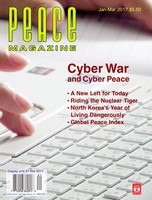
Peace Magazine Jan-Mar 2017, page 11. Some rights reserved.
Search for other articles by Manpreet Abrol here
It is almost the end of 2016, a turbulent one to say the least. Despite all of the events of this year, virtually everything has been overshadowed by the news of the 58th US presidential election. However, there is an issue surrounding this election which should be of particular concern to the public: nuclear weapons.
This year has witnessed staggering new developments by the world’s most opaque and unpredictable nuclear proliferator. The Democratic People’s Republic of Korea (DPRK, North Korea) had an eventful 12 months. The state tested its first hydrogen bomb in early January, conducted a test of its first nuclear warhead in September, violated a handful of United Nations Security Council Resolutions, told its citizenry to brace for a famine, launched countless missiles, and made numerous threats to its southern neighbors.
Before we take a deeper look at 2016, it is important to look at North Korea’s actions at the end of 2015. Had public policy analysts done so, what unfolded in January should have been no surprise. On November 28, 2015, the DPRK test-fired the Bukkenkseong-1, a submarine-launched ballistic missile (SLBM), followed by another test on December 21. The first was regarded as a complete failure, whereas the second was viewed as an overwhelming success.
The international community did not pay much attention—but then came January 6, 2016. Beginning on the worst possible front, the DPRK successfully carried out its fourth nuclear test, this time with what it claimed to be a hydrogen bomb. Since it had a yield one hundred times more powerful than that of the previous weapons test, the United Nations clearly took note. On March 2, the UN Security Council unanimously passed Security Council Resolution 2270, which called for North Korea to comply with all resolutions currently in place. In addition, the Council took unprecedented actions and asked member states to continue inspecting all North Korean cargo from land, air, and sea; to discourage all travel to the DPRK; and to ban exports of energy-related materials (such as iron, coal, and titanium).
As expected, the demand for compliance fell on deaf ears. On March 9, the national media outlet released an image of the Supreme Leader, Kim Jong-Un, next to a nuclear warhead. Shortly thereafter, he addressed the people and warned them to prepare for a famine.
As happened in the mid-1990s, when up to three million died through famine, Kim declared that “we may have to go on an arduous march, during which we will have to chew the roots of plants once again.” As an alternative, he called for a “70-day campaign of loyalty,” and asked people to donate two pounds of rice to the state warehouses each month.
Refusing to surrender any of its nuclear capabilities, the DPRK conducted another missile test on April 9, launching a long-range liquid-fuel engine which, Kim argued, could undoubtedly reach US soil. According to aerospace engineer, Dr. John Schilling, this technology is capable of a 10,000 to 13,000 km range—enough reach the US east coast. This was followed by yet another SLBM test on April 23, and then one more on May 31, of the Musudan missile. Although it was the third failed test in two months, it clearly demonstrates the relentless pursuit of nuclear capability by Kim Jong-Un.
North Korea’s fourth test of a Musudan missile, the Hwasong-10, proved to be a partial success. North Korean state media claimed that on June 22nd, the rocket landed accurately in waters about 400 km down-range from the Sea of Japan. South Korea’s Joint Chiefs of Staff noted that the DPRK had “significantly improved their Musudan missile’s engine technology.”
Despite its success, the Musudan missile was still unreliable. However, reports from the DPRK projected that its intercontinental ballistic missiles (ICBMs) would reach operational status within the next decade.
On August 24, it was reported that North Korea had launched another SLBM, which flew about 500 km towards the Japanese coast. This had ultimately demonstrated technological improvements by the regime, although it was an issue of high concern for the states bordering the Sea of Japan, and rightfully so. Just a couple weeks later on September 9, seismic evidence indicated that North Korea had successfully conducted its fifth nuclear test. With an estimated yield of at least 10 kilotons, it put the international community on edge. The DPRK also claimed that the newly tested warhead was capable of being mounted on a ballistic missile, confirming suspicions that emerged late in 2015.
With a handful of other missile and rocket launches over the course of the year, the most recent in October, North Korea has been on the radar of all major global powers. Neither efforts by global powers such as the United States, nor sanctions by the Security Council and other multilateral embargos, have apparently hindered North Korea’s commitment to nuclear proliferation.
The international community has taken a number of actions, none of them successful. Although some of the regime’s behavior may be explicable (that is, arguing that proliferation is a direct result of US regional provocation), it is nonetheless inexcusable and could result in cataclysmic repercussions.
In my opinion, the only way to denuclearize or hinder North Korean proliferation is to convene a seventh round of the Six-Party Talks. To do this, China, and to some extent Russia, will need to wholeheartedly commit to the Security Council resolutions and to internationally-agreed embargoes, and to take a more punitive stance against the totalitarian state. If nothing changes, the likeihood of nuclear catastrophe can only be expected to grow.
Manpreet Abrol is a Master’s graduate from the University of Western Ontario. He has studied the history of North Korea’s nuclear proliferation, and solutions to denuclearize it.

Peace Magazine Jan-Mar 2017, page 11. Some rights reserved.
Search for other articles by Manpreet Abrol here